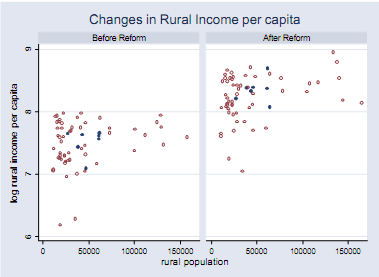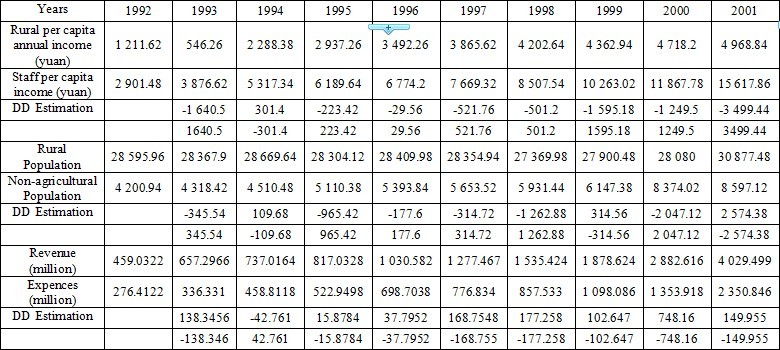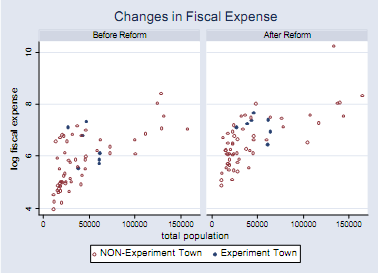Introduction
Analysis of Chinese Household Registration System Reform Impact in Zhejiang Province is required for the proper assessment of the differences and changes that has been made in this system. Assessment will help to define the effectiveness of the system as well as the importance of the innovations implemented into the registration system. The Differences-in-Differences analysis will help to estimate the key changes that have been implemented, and analyze the regression level, as in accordance with the assessment methodology, the key aim of the evaluation is to define the common trends in assumptions, assess the stable group composition, and allow no spill over effects. Therefore, considering the fact that the actual reform data is associated with the Zhejiang Province, the analysis will be performed from the perspectives of Treatment Group, and Comparison Group.
Policy Description
The policy is intended for regulating the migration process within Zhejiang Province. This is required for regaining the required balance between urban and rural population of the province that is needed for removing large gaps in the incomes. Additionally, it is also stated that these inequalities are associated with improper household registration system adopted in the province.
Hence, it is stated that the improvement of the registration system will be required for improving the entrepreneurial background within the province, and the additional reforms are significant for enforcing the governmental control for the incomes, migration, and activity of the citizens. The essence of the reform is in the reallocation of the investment funds, guaranteeing of bank loans, improvement of the educational system effectiveness, especially in the sphere of primary and secondary education, and development of public initiatives and infrastructural constructions.
As it is emphasized by Huang and Gewei (2003), the reform is impossible without the improvement of financial flows control in rural and urban districts. The long-term plans of the reform are to stimulate the decrease of migration levels, for the working and agricultural families had an opportunity to create dynasties. Huang and Gewei (2003) in their research emphasize that trial period of a similar reform had been studied on the governmental level, and specific points (Huang and Gewei) were added for improving the effectiveness of the reform:
- Creation of self-government bodies in rural districts
- Increase of the income level for agricultural workers
- Stimulation of the population growth
- Reform of labour market (implementation of strict regulation policy principles)
- Liberalization of the urban household registration system
- Development of scientific city planning
Methodology Description
The key principle of the analysis methodology is closely linked with the values of DiD assessment strategy, and it should be emphasized that this methodology is based on the assessment of the regression values that are observed after proper analysis of the average change of the treatment and comparison groups. This presupposes that the effects of the comparison of treatment groups are linked with the treatment of the control group. As it was stated by Mcmullen and Tanaka (2002, pp. 16):
“Naively, you might consider simply looking at the treatment group before and after treatment to try to deduce the effect of the treatment. However, many other things were surely going on at exactly the same time as the treatment. DID uses a control group to subtract out other changes at the same time, assuming that these other changers were identical between the treatment and control groups.”
In the light of this statement, it should be emphasized that the accurate estimation of the groups remains the same regardless of the analyzed serial correlation issues. As for the matters of DiD analysis in general, the weak point of this estimation is associated with the fact that the analysis is not accurate if something else changes between the groups besides the analyzed factor.
The methodology itself is based on the indicators that are formed in accordance with the regression levels in such spheres as Agricultural Population, Non-Agricultural Population, Annual Per Capita Income of Rural and Non-Rural, and Financial Income and Expenditure. These values form the analysis data that are further used for evaluating the urbanized estimator. A reasonable criteria for performing a reliable estimator calculation should be unbiased, and mathematically grounded. This estimator may be calculated in accordance with the formula below:
The assumption that is needed for the Differences-in-Differences estimator is linked with correct equation of the correctly specified results. Since, the actual treatment effect depends on the permanent differences, the control groups that exist independently of the control measures are used for randomized experiments. In this case, the rate of estimator value is useful for the experimental setting that is generally out of availability, and the program evaluation may be economy related only.
As for the threats, associated with the offered methodology, it should be emphasized that the general values of the estimations, average parameters, and regression values will be regarded as the average values, especially, if the estimations of the effectiveness level are too high (Hendry, 2004). This is explained by the fact that Differences-in-Differences estimator values are linked with the regression values, and the higher estimations (that do not consider regressions), cause poorer calculation effectiveness. Therefore, the methodology may be effective only if estimation parameters are adjusted properly.
As it was emphasized by Besley and Case (2000, p. 682), the Diff-in-Diff estimator coefficients generally do not reveal intensive increase in the labour market, as well as the wage growth. Additionally, this may be regarded as a breakdown for the parallel trend assumption, and considering the regarded system identification and reformation, such a trend is the stimulation of the population increase. Nevertheless, the insignificant growth of these parameters is not suitable for proper analysis, and this looks controversial.
In the light of this statement, it should be emphasized that the possible problems may be also linked with the assumptions that are not related with unbiased estimation coefficients. However, as Charemza and Deadman (2004) emphasize, this may be hard enough to check all the related assumptions, especially if the parameters and parameters are unobservable. Considering the Chinese Household Registration System Reform Impact in Zhejiang Province, these parameters are linked with the estimation o Chinese governmental logic that is used for the reforms, and household registration system that was adopted before the generally accepted registration principles.
Kim and Triverdi (2004) claim that small deviations that are kept in mind but are not registered in the calculations may not matter in this case, as most of them are biased, and require thorough reconsideration within the frames of regression analysis. It is also stated that biases may be huge enough, as the general perspectives of the estimations may be completely wrong, especially if the problem is regarded only from the perspective or rural development. (Lesage and Parent, 2007)
The key research by Huang and Gewei (2003), showed that the main reason of the inequity in incomes of the rural citizens was the ineffective drawback of the household registration system, as well as the imperfect labour market policy that was intended for restriction of farmers’ participation in urban development. Therefore, occupation level in agricultural sector was regarded as the part of economic growth income, and since the household market regulations were strict enough, lots of rural citizens migrated to cities that were not involved into the agricultural sector of Chinese economic system. (Watson and Teelucksingh, 2002)
The aim of the new system is to regulate this migration in order to stop the gap growth between urban and rural districts. As for the offered DiD methodology for the assessment of the Chinese Household Registration System Reform Impact in Zhejiang Province, it should be emphasized that the actual differences and variations may appear because of standard errors allowed in the regression analysis. Hence, in accordance with the statement by Meyer (2002, p. 158):
“Conventional DID standard errors severely understate the standard deviation of the estimators: we find an “effect” significant at the 5 percent level for up to 45 percent of the placebo interventions. To alleviate this problem two corrections based on asymptotic approximation of the variance-covariance matrix work well for moderate numbers of states and one correction that collapses the time series information into a “pre” and “post” period and explicitly takes into account the effective sample size works well even for small numbers of states.”
The practical focus of the analysis is grounded on the review of the demographic and economic parameters stated and analyzed in the case description. The most important parameter for the analysis is rural income per capita. In accordance with the DiD calculations, the income had been growing for the analyzed period (1992 – 2001), and growth of rural population is regarded as the result of the successful reform implementation. The results of the rural income per capita are given on figure 1.

Differences-in-Differences estimation on the matters of Rural per capita annual income / Staff per capita income, rural / non-agricultural population, Revenue / Expenses are given in the table 1 below:

In accordance with the analysis performed on these values, it should be stated that the results reveal positive outcomes of the Chinese Household Registration System Reform, as the financial parameters, and DiD analysis revel positive tendencies. Hence, the actual importance of the quasi experiment in economic system, as it is emphasized by Meyer (1995), involves the opportunity to assess all the possible outcomes of the reform in advance.
However, instead of operating with the collected data, such an analysis will require clear definition of the estimation criteria, and calculation of the Difference-in Difference coefficient. Considering the calculations of the given values, these coefficients will be: “4.1” for Rural per capita annual income / Staff per capita income, “11.1” for Rural / non-agricultural population and “2.9” for Revenue / expenses.
Strengths and Limitations of the Approach
The selected analysis approach is featured with the powerful basis for financial performance forecast, nevertheless, the results may be accurate only if all the financial parameters are included. Therefore, as it is stated by Meyer (2002, p. 155):
“It is possible to remove the time series dimension by aggregating the data into two periods: pre- and post-intervention. If one adjusts the statistics for the small number of observations, this correction works well even when the number of groups is relatively small. Second, one can allow for an unrestricted covariance structure over time within provinces, with or without assuming that the error terms in all control areas follow the same process. This technique works well when the number of groups is large but fares more poorly as the number of groups gets small.”
In the light of this fact, it should be emphasized that values of the financial analysis for the given areas is linked with the opportunity to analyze the effectiveness of the reforms, and offer the necessary recommendations that will consider all the possible valuations for further improvement of the analyzed parameters. However, the high credibility of negative average treatment effect may be an essential limitation for the method. On the one hand, this means that control measures are effective enough, on the other hand this may be a sign for improperly selected parameters.
The strengths that should be considered are linked with the values of labour market growth and development. Therefore, the reforms managed to decrease the gap between rural and urban market growth, and the analysis point of this fact is directed at the opportunity to evaluate the financial expense changes that have been observed in the financial system (Figure 2).

External Validity Issues
External validity of the DiD analysis is based on the principles of effective financial and statistical analysis of the labour market output, as well as the values of the general revenue / expense correlation. As it is emphasized by Bertrand and Duflo (2004, p. 255):
“The income residuals is informative. It is estimated that autocorrelation coefficients for the mean state are the year residuals from a regression of wages on state and year dummies. The autocorrelation coefficients are obtained by a simple OLS regression of the residuals on the corresponding lagged residuals. We are therefore imposing common autocorrelation parameters for all states. The estimated first-order autocorrelation coefficient is strongly significant.”
This means that the validity level of the method is closely linked with the values of the methodology strengths, as well as the opportunities of the system reform. This means that the actual significance of the validity analysis is neglected in the regression analysis, nevertheless, the principles of DiD stay the same, and validity of the formal definition of the correlations and depreciations is not included into the initial data.
Conclusion
Chinese Household Registration System Reform Impact in Zhejiang Province resulted in the rapid growth of the labour market in the agricultural sphere, and caused the growth of the income per capita within the clearly defined geographic region. On the one hand, the reformation was successful, on the other hand, the DiD analysis revealed some drawbacks and demerits linked with the improper analysis of the initial parameters. Nevertheless, the offered methodology is effective enough, and this was quite helpful for identifying the expectation coefficients, as well as the calculation of DDσ values that are crucial for further analysis of the growth tempos.
As for the strategy strengths and limitations, it should be emphasized that theses are linked with the accuracy of initial parameters calculation and analysis of the regression values. These are performed in accordance with the given methodology, and reveal that the reforms required liberalization of the labour market, as well as the household registration system.
References
Bertrand, M., Duflo, E. 2004. How Much Should We Trust Differences-in-Differences Estimates? The Quarterly Journal of Economics. Harvard College and the Massachusetts Institute of Technology.
Besley, T., Case, A. 2000. Unnatural Experiments? Estimating the Incidence of Endogenous Policies. The Economic Journal, 110, F672-F694.
Charemza, W. W., & Deadman, D. F. 2004. New Directions in Econometric Practice: General to Specific Modelling, Cointegration, and Vector Autoregression. Lyme, NH: Edward Elgar.
Hendry, D. F. 2004. Econometrics: Alchemy or Science? : Essays in Econometric Methodology. Oxford: Oxford University Press.
Huang, Y., Gewei, W. 2003. Labor Market Deregulations and Migration Consequences in China. Evidence from the Household Registration Reform Program. China Center for Economic Research. Peking University.
Kim, J., & Trivedi, P. K. 2004. Econometric Time Series Analysis: A Review. The American Statistician, 48(4), 336.
Lesage, J. P., & Parent, O. 2007. Bayesian Model Averaging for Spatial Econometric Models. Geographical Analysis, 39(3), 241.
Mcmullen, B. S., & Tanaka, H. 2002. An Econometric Analysis of Differences between Motor Carriers: Implications for Market Structure. Quarterly Journal of Business and Economics, 34(4), 16.
Meyer, B. 2002. Natural and Quasi-Experiments in Economics. Journal of Business & Economic Statistics, Vol. 13, No. 2.
Watson, P. K., & Teelucksingh, S. S. (2002). A Practical Introduction to Econometric Methods Classical and Modern. Barbados: University of the West Indies Press.